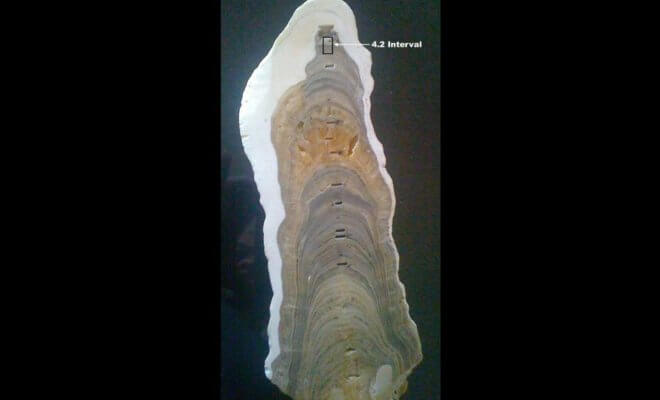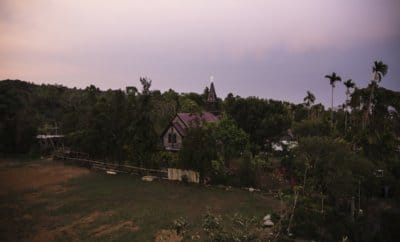India
Meghalayan Age: Latest Era in Earth’s History Named After Indian State

The stalagmite from India with the GSSP for the beginning of Meghalayan Age.
Photo: Twitter/ @theIUGS
The last 4,200 years have been classified by geologists as a new distinct age in Earth’s history, called the “Meghalayan Age,” named after the northeastern Indian state.
The last 4,200 years have been classified by geologists as a new distinct age in Earth’s history, called the “Meghalayan Age,” named after the Indian state of Meghalaya.
The new age, which was brought about by a global drought that had severe consequences for various civilizations, will now appear on all official charts depicting Earth’s geological history, the International Commission on Stratigraphy (ICS) announced at a meeting held in June.
The International Chronostratigraphic Chart is updated to show the Meghalayan Age as the youngest slice of Earth’s 4.6-billion-year geological history, incorporated into the Holocene Epoch, the last 11,700 years on the planet that began with the end of the Ice Age. This epoch also includes the Greenlandian Age — the oldest phase of the Holocene — and the Northgrippian Age, which dates from 8,300 years ago up to the beginning of the Meghalayan.
The latest version of the International Chronostratigraphic Chart/Geologic Time Scale is now available! New #Holocene subdivisions: #Greenlandian (11,700 yr b2k)#Northgrippian (8326 yr b2k)#Meghalayan (4200 yr before 1950) https://t.co/IhvZHfHnWh#ChronostratigraphicChart208 pic.twitter.com/8Pf9Dnct7h
— IUGS (@theIUGS) July 13, 2018
The Meghalayan goes back 4,200 years, when a devastating drought severely impacted civilizations in Egypt, Greece, Syria, Palestine, Mesopotamia, the Indus Valley, and the Yangtze River Valley over two centuries.
The proposal for the Meghalayan age was floated around six years back, after distinct chemical signals were detected for the transition to a new age in the stalagmites rising from the floor of the Mawmluh cave near Cherrapunji in the northeastern Indian state.
The layers of the stalagmite showed a change in the isotopes of oxygen atoms due to weakened monsoons. “The isotopic shift reflects a 20-30% decrease in monsoon rainfall,” Prof Mike Walker of the University of Wales, UK, who led the international team of Holocene scientists that developed the division proposal, told BBC News.
“The two most prominent shifts occur at about 4,300 and about 4,100 years before present, so the mid-point between the two would be 4,200 years before present, and this is the age that we attribute to the [Meghalayan golden spike],” he added.
The Meghalayan is a unique division in the time scale because it marks a major global cultural event that resulted from a global climatic happening, the report cited Stanley Finney, professor of geological sciences at Long Beach State University and Secretary-General of the International Union of Geological Sciences (IUGS), which ratified the ICS proposal, as saying.
Some scientists, however, are not convinced about the move to label a new Meghalayan Age, especially since deliberations are still going on about identifying a new time period — tentatively called the Anthropocene — that would recognize the impact of human activity on the planet.
“After the original paper and going through various committees, they’ve suddenly announced [the Meghalayan] and stuck it on the diagram,” Mark Maslin, a professor of geography at University College London, UK, told the publication. “It’s official, we’re in a new age; who knew? We have lots of new definitions that perhaps now contradict the Anthropocene Working Group and go against what most scientists perceive to be the most important change on Earth in the last 10,000 years.”
Prof Walker, however, dismissed the objections. “To be frank, I see absolutely no conflict at all between the new subdivisions that we have here and a future designation of the Anthropocene,” he told the BBC.
“These subdivisions of the Holocene are based entirely on physical (climatic/ environmental) evidence whereas any designation of the Anthropocene as a new unit within the geological timescale would rest entirely on evidence for human impact.”
Meanwhile people in India, and especially Meghalaya, are ecstatic with the recognition that the state has got.
“I think this is a very proud moment for everybody in Meghalaya. It’s a global phenomenon where the history of the earth and humanity is named after Meghalaya,” Meghalaya Chief Minister Conrad Sangma said, the Hindustan Times reported. “In fact we can proudly say, we are living in our age,” he added, pointing out that right policies are needed to protect the vast network of caves, such as the Mawmluh cave, that are found in the state.

